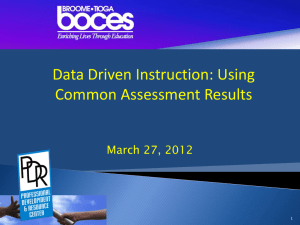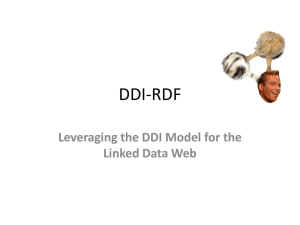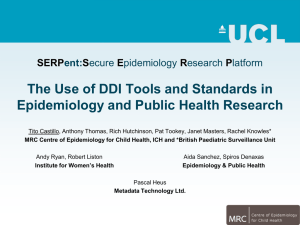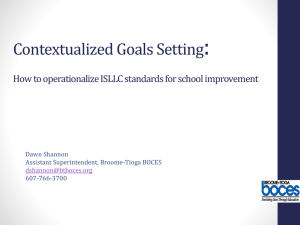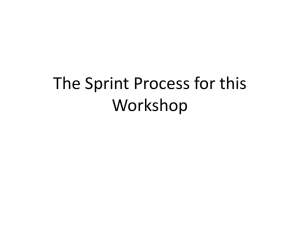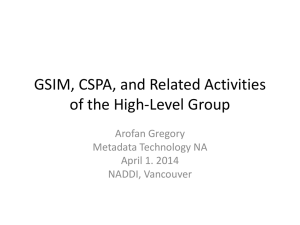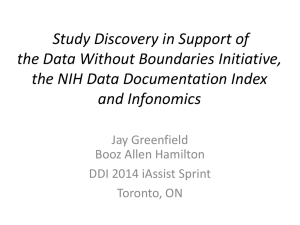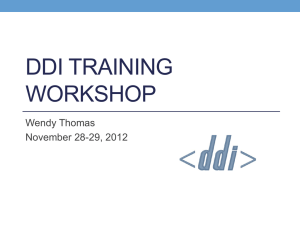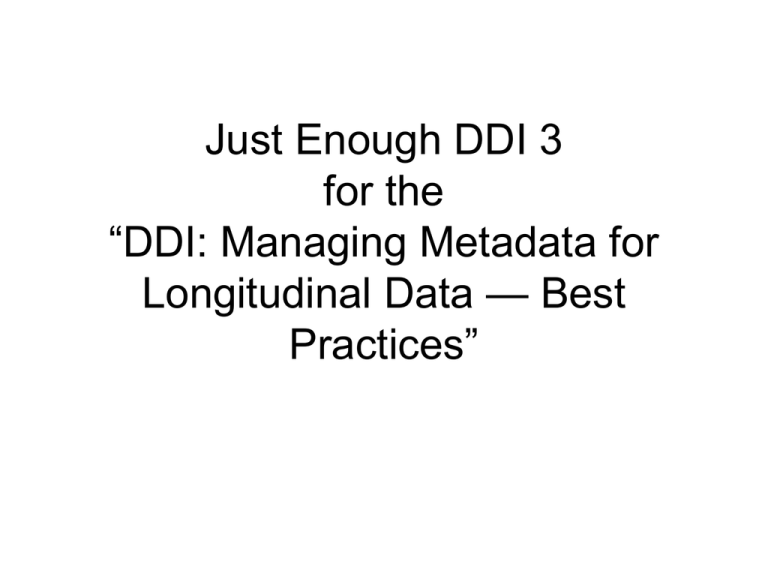
Just Enough DDI 3
for the
“DDI: Managing Metadata for
Longitudinal Data — Best
Practices”
Overview
• This is a short summary of DDI features,
intended to introduce non-IT-technical students
to DDI 3
• Each working group will have participants who
are very familiar with DDI 3 and its technical
implementation
• It is important that we have introduced the
terminology and basic concepts of DDI 3 so we
can discuss its use in managing longitudinal
surveys and their metadata
DDI Content Overview
• DDI 3 may seem very technical
– It is not an invention!
– It is based on the metadata used across many
different organizations for collecting, managing, and
disseminating data
• This section introduces the types of metadata
which are the content of DDI
– Not a technical view, but a business view
– You work with this metadata every day – it should be
familiar to you
– You may use different terminology
Basic Types of Metadata
• Concepts (“terms”)
• Studies (“surveys”, “collections”, “data
sets”, “samples”, “censuses”, “trials”,
“experiments”, etc.)
• Survey instruments (“questionnaire”,
“form”)
• Questions (“observations”)
• Responses
Basic Types of Metadata (2)
• Variables (“data elements”, “columns”)
• Codes & categories (“classifications”,
“codelists”)
• Universes (“populations”, “samples”)
• Data files (“data sets”, “databases”)
using
Survey
Instruments
Study
made up of
measures
about
Questions
Concepts
Universes
with values of
Questions
Variables
collect
made up of
Responses
Data Files
resulting in
Categories/
Codes,
Numbers
Reuse Across the Lifecycle
• This basic metadata is reused across the
lifecycle
– Responses may use the same categories and
codes which the variables use
– Multiple waves of a study may re-use
concepts, questions, responses, variables,
categories, codes, survey instruments, etc.
from earlier waves
Reuse by Reference
• When a piece of metadata is re-used, a
reference can be made to the original
• In order to reference the original, you must
be able to identify it
• You also must be able to publish it, so it is
visible (and can be referenced)
– It is published to the user community – those
users who are allowed access
Change over Time
• Metadata items change over time, as they move
through the data lifecycle
– This is especially true of longitudinal/repeat crosssectional studies
• This produces different versions of the metadata
• The metadata versions have to be maintained
as they change over time
– If you reference an item, it should not change: you
reference a specific version of the metadata item
DDI Support for Metadata Reuse
• DDI allows for metadata items to be identifiable
– They have unique IDs
– They can be re-used by referencing those IDs
• DDI allows for metadata items to be published
– The items are published in resource packages
• Metadata items are maintainable
– They live in “schemes” (lists of items of a single type) or in
“modules” (metadata for a specific purpose or stage of the
lifecycle)
– All maintainable metadata has a known owner or agency
• Maintainable metadata can be versionable
– This reflects changes over time
– The versionable metadata has a version number
Study A
Study B
Ref=
“Variable X”
uses
re-uses by
reference
Variable ID=“X”
Resource Package
published in
Variable Scheme ID=“123” Agency=“GESIS”
contained in
Variable ID=“X” Version=“1.0”
changes over time
Variable ID=“X” Version=“1.1”
changes over time
Variable ID=“X” Version=“2.0”
Data Comparison
• To compare data from different studies (or even waves of the
same study) we use the metadata
– The metadata explains which things are comparable in data sets
• When we compare two variables, they are comparable if
they have the same set of properties
– They measure the same concept for the same high-level universe,
and have the same representation (categories/codes, etc.)
– For example, two variables measuring “Age” are comparable if they
have the same concept (e.g., age at last birthday) for the same toplevel universe (i.e., people, as opposed to houses), and express their
value using the same representation (i.e., an integer from 0-99)
– They may be comparable if the only difference is their representation
(i.e., one uses 5-year age cohorts and the other uses integers) but
this requires a mapping
DDI Support for Comparison
• For data which is completely the same, DDI provides a
way of showing comparability: Grouping
– These things are comparable “by design”
– This typically includes longitudinal/repeat cross-sectional studies
• For data which may be comparable, DDI allows for a
statement of what the comparable metadata items are:
the Comparison module
– The Comparison module provides the mappings between similar
items (“ad-hoc” comparison)
– Mappings are always context-dependent (e.g., they are sufficient
for the purposes of particular research, and are only assertions
about the equivalence of the metadata items)
Study A
Study B
Group
uses
Variable A
uses
uses
Variable A
Variable A
Variable B
Variable B
Variable C
Variable C
Variable D
Variable X
Variable B
Variable C
contains
Study A
contains
Study B
uses
Variable D
uses
Variable X
Comparison Module
Is the Same As
Study A
Study B
uses
Is the Same As
Variable A
Variable B
Variable W
Is the Same As
Variable C
Variable D
uses
Variable X
Variable Y
Is the Same As
Variable Z
DDI 3 in More Detail
DDI 3 Lifecycle Model
S03
Metadata Reuse
19
DDI within a Research Project
• This example shows how DDI 3 can support
various functions within a research project, from
the conception of the study through collection
and publication of the resulting data.
S06
20
Prinicpal
Investigator
Research Staff
Collaborators
<DDI 3>
Concepts
Universe
Methods
Purpose
People/Orgs
+
Submitted
Proposal
<DDI 3>
Funding
Revisions
$
€£
+
<DDI 3>
Variables
Physical Stores
<DDI 3>
Questions
Instrument
+
+
<DDI 3>
Data Collection
Data Processing
Presentations
+
Publication
Data
Archive/
Repository
Introduction to XML Structure and
Metadata
• How this section is structured
– High-level view of the XML structure
– Introduction to the modules and what
metadata they contain
– A first look at DDI “schemes” and reusable
metadata
S04
22
XML Schemas, DDI Modules,
and DDI Schemes
XML Schemas
DDI Modules
Correspond
to a stage in
the lifecycle
<file>.xsd
<file>.xsd
<file>.xsd
<file>.xsd
May
Correspond
May
Contain
DDI Schemes
S09
23
DDI Instance
Citation
Coverage
Other Material / Notes
Translation Information
Study Unit
3.1 Local
Holding
Package
S04
Group
Resource
Package
24
Study Unit
Citation / Series Statement
Abstract / Purpose
Coverage / Universe / Analysis Unit / Kind of Data
Other Material / Notes
Funding Information / Embargo
Conceptual
Components
Physical
Instance
S04
Data
Collection
Logical
Product
Archive
Physical
Data
Product
DDI
Profile
25
Group
Citation / Series Statement
Abstract / Purpose
Coverage / Universe
Other Material / Notes
Funding Information / Embargo
Conceptual
Components
Sub Group
Data
Collection
Logical
Product
Study Unit
Comparison
Physical
Data
Product
DDI
Profile
Archive
S04
26
Resource Package
Citation / Series Statement
Abstract / Purpose
Coverage / Universe
Other Material / Notes
Funding Information / Embargo
Any module
EXCEPT
Study Unit
or
Group
S04
Any Scheme:
Organization
Concept
Universe
Geographic Structure
Geographic Location
Question
Interviewer Instruction
Control Construct
Category
Code
Variable
NCube
Physical Structure
Record Layout
27
3.1 Local Holding Package
Citation / Series Statement
Abstract / Purpose
Coverage / Universe
Other Material / Notes
Funding Information / Embargo
Depository
Study Unit OR
Group
Reference:
[A reference to
the stored
version of the
deposited study
unit.]
S04
Local Added
Content:
[This contains all
content available
in a Study Unit
whose source is
the local archive.]
28
DDI 3 Lifecycle Model and Related Modules
Groups and Resource Packages are a
means of publishing any portion or
combination of sections of the life cycle
Study
Unit
S04
Data
Collection
Logical
Product
Local
Holding
Package
Physical
Data
Product
Physical
Instance
Archive
29
DDI Schemes
• Brief overview of what DDI schemes are
and what they are designed to do
including:
– Purpose of DDI Schemes
– How a DDI Study is built using information
held in schemes
S04
30
DDI Schemes: Purpose
• A maintainable structure that contains a list of
versionable things
• Supports registries of information such as concept,
question and variable banks that are reused by multiple
studies or are used by search systems to location
information across a collection of studies
• Supports a structured means of versioning the list
• May be published within Resource Packages or within
DDI modules
• Serve as component parts in capturing reusable
metadata within the life-cycle of the data
S04
31
S04
32
Building from Component Parts
UniverseScheme
CategoryScheme
NCube
Scheme
CodeScheme
ConceptScheme
QuestionScheme
ControlConstructScheme
Variable
Scheme
RecordLayout
Scheme
[Physical Location]
Instrument
LogicalRecord
PhysicalInstance
Versioning and Maintenance
• There are three classes of objects:
– Identifiable (has ID)
– Versionable (has version and ID)
– Maintainable (has agency, version, and ID)
• Very often, identifiable items such as
Codes and Variables are maintained in
parent schemes
S08
33
Maintenance Rules
• A maintenance agency is identified by a reserved code
based on its domain name (similar to it’s website and email)
– There is a register of DDI agency identifiers which we will look at
later in the course
• Maintenance agencies own the objects they maintain
– Only they are allowed to change or version the objects
• Other organizations may reference external items in their
own schemes, but may not change those items
– You can make a copy which you change and maintain, but once
you do that, you own it!
S08
34
Publication in DDI
• There is a concept of “publication” in DDI which is
important for maintenance, versioning, and re-use
• Metadata is “published” when it is exposed outside the
agency which produced it, for potential re-use by other
organizations or individuals
– Once published, agencies must follow the versioning rules
– Internally, organizations can do whatever they want before
publication
• Note that an “agency” can be an organization, a
department, a project, or even an individual for DDI
purposes
– It must be described in an Organization Scheme, however!
• There is an attribute on maintainable objects called
“isPublished” which must be set to “true” when an object
is published (it defaults to “false”)
S08
35
Versioning Rules
• If a “published” object changes in any way, its
version changes
• This will change the version of any containing
maintainable object
• Typically, objects grow and are versioned as
they move through the lifecycle
• Versions inherit their agency from the
maintainable scheme they live in
S08
36
S08
37
Versioning Across the DDI 3
Lifecycle Model
Version
3.0.0
Version
1.0.0
Version
1.1.0
Version
2.0.0
Versioning: Changes
ConceptScheme X
V 1.0.0
- Concept A v 1.0.0
- Concept B v 1.0.0 references
- Concept C v 1.0.0
ConceptScheme X
V 1.1.0
- Concept A v 1.1.0
- Concept B v 1.0.0 references
- Concept C v 1.1.0
Add:
Concept D v 1.0.0
Note: You can also reference entire
schemes and make additions
references
S08
ConceptScheme X
V 2.0.0
- Concept A v 1.2.0
- Concept B v 1.0.0
- Concept C v 1.2.0
- Concept D v 1.1.0
Add:
Concept E v 1.0.0
references
ConceptScheme X
V 3.0.0
- Concept D v 1.1.0
- Concept E v 1.0.0
38
Example of Schemes and Modules: A Schematic
Study Unit
Logical
product
Physical data
product
Concepts
Variables
Record
Layout
Universes
Codes
Conceptual
component
Physical
instance
Data collection
Questions
S09
Categories
Category
Stats
39
Basic Metadata Types: Details
•
•
•
•
•
•
Concepts
Universes
Instruments
Questions
Response Domains/Representations
Variables
Concepts
• A concept may be structured or
unstructured and consists of a Name, a
Label, and a Description. A description is
needed if you want to support comparison.
Concepts are what questions and
variables are designed to measure and
are normally assigned by the study
(organization or investigator).
S10
41
Universe
• This is the universe of the study which can
combines the who, what, when, and where
of the data
• Census top level universe: “The population
and households within Kenya in 2010”
• Sub-universes: Households, Population,
Males, Population between 15 and 64
years of age, …
S10
42
Universe Structure
• Hierarchical
– Makes clear that “Owner Occupied Housing
Units” are part of the broader universe
“Housing Units”
– Can be generated from the flow logic of a
questionnaire
• Referenced by variables and question
constructs
S10
– Provides implicit comparability when 2 items
reference the same universe
43
Population and Housing
Units in Kenya in 2010
Housing
Units
Population
Males
Variable A
Universe Reference:
S10
Persons
15 years
and Older
Males, 15 years of
age and older
44
Questionnaires
• Questions
– Question Text
– Response Domains
• Statements
– Pre- Post-question text
– Routing information
– Explanatory materials
• Question Flow
S11
45
Simple Questionnaire
Simple Questionnaire:
1. Sex
(1) Male
(2) Female
2. Are you 18 years or older?
(0) Yes
(1) No (Go to Question 4)
3. How old are you? ______
4. Who do you live with?
__________________
5. What type of school do you attend?
(1) Public school
(2) Private school
(3) Do not attend school
S11
46
Simple Questionnaire
Simple Questionnaire:
1. Sex
(1) Male
(2) Female
2. Are you 18 years or older?
(0) Yes
(1) No (Go to Question 4)
3. How old are you? ______
4. Who do you live with?
__________________
5. What type of school do you attend?
(1) Public school
(2) Private school
(3) Do not attend school
S11
• Questions
47
Simple Questionnaire
Simple Questionnaire:
1. Sex
(1) Male
(2) Female
2. Are you 18 years or older?
(0) Yes
(1) No (Go to Question 4)
3. How old are you? ______
4. Who do you live with?
__________________
5. What type of school do you attend?
(1) Public school
(2) Private school
(3) Do not attend school
S11
• Questions
• Response
Domains
– Code
– Numeric
– Text
48
Instruments and Flow Logic
• Look at the simple questionnaire
S11
49
Simple Questionnaire
Simple Questionnaire:
1. Sex
(1) Male
(2) Female
2. Are you 18 years or older?
(0) Yes
(1) No (Go to Question 4)
3. How old are you? ______
4. Who do you live with?
__________________
5. What type of school do you attend?
(1) Public school
(2) Private school
(3) Do not attend school
S11
• Questions
• Response
Domains
– Code
– Numeric
– Text
• Statements
50
Simple Questionnaire
Simple Questionnaire:
1. Sex
(1) Male
(2) Female
2. Are you 18 years or older?
Skip Q3
(0) Yes
(1) No (Go to Question 4)
3. How old are you? ______
4. Who do you live with?
__________________
5. What type of school do you attend?
(1) Public school
(2) Private school
(3) Do not attend school
S11
• Questions
• Response
Domains
– Code
– Numeric
– Text
• Statements
• Flow
51
Question 1
Question 2
Is Q2 = 0 (yes)
No
Yes
Question 3
S11
Question 4
Question 5
52
Flow Logic
• Master Sequence
– Every instrument has one top-level sequence
• Question and statement order
• Routing – IfThenElse (see next slide)
– After Statement 2 (all respondents read this)
– After Q2 Else goes to statement
– After Q5 Else goes back to a sequence
S11
53
Else
SI 1
Q1
IfThenElse
1
SI 2
end
Then
IfThenElse
2
Q2
Else
SI 3
Then
Else
Q3
Q4
IfThenElse
3
Q5
Q8
SI 4
Then
Q6
S11
Q7
54
Example: Master Sequence
•
•
•
•
Statement 1
Question 1
Statement 2
IFThenElse 1
– Then SEQuence1
• Question 2
• IFThenElse 2
– Then SEQuence 2
Question 3, Question 4, IFThenElse 3, Question 8,
Statement 4
[Then SEQuence 3 (Question 6,Question 7)]
– Else Statement 3
S11
55
Representing Response Domains
• There are many types of response
domains
– Many questions have categories/codes as
answers
– Textual responses are common
– Numeric responses are common
– Other response domains are also available in
DDI 3 (time, mixed responses)
S11
56
Category and Code Domains
•
Use CategoryDomain when NO codes
are provided for the category response
[ ] Yes
[ ] No
•
Use CodeDomain when codes are
provided on the questionnaire itself
1. Yes
2. No
S11
57
Category Schemes and Code
Schemes
• Use the same structure as variables
• Create the category scheme or schemes
first (do not duplicate categories)
• Create the code schemes using the
categories
– A category can be in more than one code
scheme
– A category can have different codes in each
code scheme
S11
58
Numeric and Text Domains
• Numeric Domain provides information on the
range of acceptable numbers that can be
entered as a response
• Text domains generally indicate the maximum
length of the response
• Additional specialized domains such as
DateTime are also available
• Structured Mixed Response domain allows for
multiple response domains and statements
within a single question, when multiple response
types are required
S11
59
General Variable Components
• VariableName, Label and Description
• Links to Concept, Universe, Question, and
Embargo information
• Provides Analysis and Response Unit
• Provides basic information on its role:
– isTemporal
– isGeographic
– isWeight
• Describes Representation
S12
60
Grouping and Comparison
Group:
Grouping and Inheritance
• Grouping is the feature which allows DDI 3 to
package groups of studies into a single XML
instance, and express relationships between
them
• To save repetition – and promote re-use – there
is an inheritance mechanism, which allows
metadata to be automatically shared by studies
• This can be a complicated topic, but it is the
basis for many of DDI 3’s features, including
comparison of studies
• There is a switch which can be used to “turn off”
inheritance
S18
62
Group Contents
• A group can contain study units, subgroups, and resource
packages:
– Study units document individual studies
– Subgroups (inline or by reference)
– Any of the content modules (Logical Product, Data Collection, etc.)
• Groups can nest indefinitely
• They have a set of attributes which explain the purpose of the group
(as well as having a human-readable description):
–
–
–
–
–
–
–
S18
Grouping by Time
Grouping by Instrument
Grouping by Panel
Grouping by Geography
Grouping by Data Set
Grouping by Language
Grouping by User-Defined Factor
63
S18
64
Inheritance
Group A
Subgroup B
Study F
Subgroup C
Study G
Study H
Study D
Study E
Study I
• Modules can be attached at any level
• They are shared – without repetition – by all child study units and subgroups
• If Group A has declared a concept called “X”, it is available to Study Units D – I.
• If Subgroup C has declared a Variable “Gender”, it is available to Study Units H
and I without reference or repetition
• Inherited metadata can be changed using local overrides which add, replace, or
delete inherited properties
Actions in Identifiers
• In some places – especially in groups where lots
of metadata is being inherited – you can Add,
Update, and Delete items using identifiers.
– Using @action attribute = Add/Delete/Update
– Repeat the identifier of the inherited object being
locally modified
• This allows for local re-definition that is not
reflected in a new version of the scheme
– It cannot be reused
• For re-use, schemes should be versioned!
S18
65
Illustrative Example, Based on German
Social Economic Panel (SOEP) Study
• The following slide shows how different
types of metadata can be shared using
grouping and inheritance
• The SOEP is a panel study, with different
panels on different years
– Variables change over time
– New questions and data are added
S18
66
Group
1997 - 2003
• Person-level information
• Satisfaction with life
• School degree
Subgroup
1998
1999
S18
• Currency is Euro
Reuse variable
scheme
by reference
• Currency is DM
• Size of Company
(v 1.0)
1997
Subgroup
Subgroup • Size of company
2002
with concerns
about Euro (v1.1)
[currency is still DM]
2000
2003
2001
67
Comparison Content
• A comparison element is placed on a group or subgroup
• It contains:
–
–
–
–
–
–
–
–
Description of the comparison
Concept maps
Variable maps
Question maps
Category maps
Code maps
Universe maps
Notes
• Each map provides for a description of how two
compared items correlate and/or differ, and also allows
for a coding to be associated with the correlation
S18
68
Ad Hoc Groups
• Creating a course specific group
– 3 files on aging
– Create the group and declare the reason for
selecting and including these studies
– Note common or comparable concepts OR
clarify why they are similar but NOT the same
– Map any needed recodes for comparability
– Provide the links (for example geographic)
S18
69
Equivalencies
• FIPS
–
–
–
–
–
–
–
–
–
S18
• CENSUS
01 Alabama
02 Alaska
04 Arkansas
06 California
08 Colorado
09 Connecticut
10 Delaware
11 District of Columbia
12 Florida
=
–
–
–
–
–
–
–
–
–
63 Alabama
94 Alaska
86 Arkansas
71 California
84 Colorado
16 Connecticut
51 Delaware
53 District of Columbia
59 Florida
70
Providing Comparative Information
• Create the category and
coding schemes
• Use the comparison
maps to provide
comparability
– Codes, Categories,
Variables, Concepts
Questions, Universe
• Example:
– 6 files using 3 different age
variables
– Single year, five year, and
ten year cohorts
S18
• Map each equivalent
structure to a single
example
• Map the single year to the
five year
• Map the five year to the
ten year
• Provide the software
command to do the
conversion
71
SINGLE YEARS
< 1 year
1 year
2 years
3 years
4 years
5 years
6 years
7 years
8 years
9 years
10 years
11 years
12 years
13 years
14 years
15 years
5 YEAR COHORTS
< 5 years
5 to 9 years
10 to 14 years
15 to 19 years
10 YEAR COHORTS
< 10 years
10 to 19 years
20 years plus
20 years plus
16 years
17 years
18 years
19 years
20 years
Etc.
S18
72
SINGLE YEARS
< 1 year
1 year
2 years
3 years
4 years
5 years
6 years
7 years
8 years
9 years
10 years
11 years
12 years
13 years
14 years
15 years
5 YEAR COHORTS
< 5 years
5 to 9 years
10 to 14 years
15 to 19 years
10 YEAR COHORTS
< 10 years
10 to 19 years
20 years plus
20 years plus
16 years
17 years
18 years
19 years
20 years
Etc.
S18
73
SINGLE YEARS
< 1 year
1 year
2 years
3 years
4 years
5 years
6 years
7 years
8 years
9 years
10 years
11 years
12 years
13 years
14 years
15 years
5 YEAR COHORTS
< 5 years
10 YEAR COHORTS
5 to 9 years
10 to 14 years
15 to 19 years
< 10 years
10 to 19 years
20 years plus
20 years plus
16 years
17 years
18 years
19 years
Each with both a human readable and
machine-actionable command
20 years
Etc.
S18
74
Comparability
• The comparability of a question or variable can be
complex. You must look at all components. For example,
with a question you need to look at:
– Question text
– Response domain structure
• Type of response domain
• Valid content, category, and coding schemes
• The following table looks at levels of comparability for a
question with a coded response domain
• More than one comparability “map” may be needed to
accurately describe comparability of a complex
component
S18
75
S18
76
Detail of question comparability
Comparison
Map
Textual Content
of Main Body
Same
Question
Similar
Category
Same
X
X
X
X
Similar
X
X
X
X
Different
X
X
X
Same
X
X
X
Code Scheme
X
X
X
X
X
X
X
X
X
X
Resource Packages
• Used to publish reusable information
outside of a specific study
• Examples:
– Geographic Code Scheme
– Industry Codes
– Question Scheme [common questions within
an organization]
– Concept Scheme
S18
77
Special Considerations
• References to external DDI Schemes can be
made at the DDI Scheme level
– Items to exclude can be listed within this reference
• Large DDI Schemes should be packaged for
easy reference of sub-sections
– For example: an overall Occupation Coding Scheme
may consist of multiple sub-Schemes for each major
Occupation Group making it easier to reference a
single Occupation Group within the overall
Occupation Coding Scheme
S18
78

